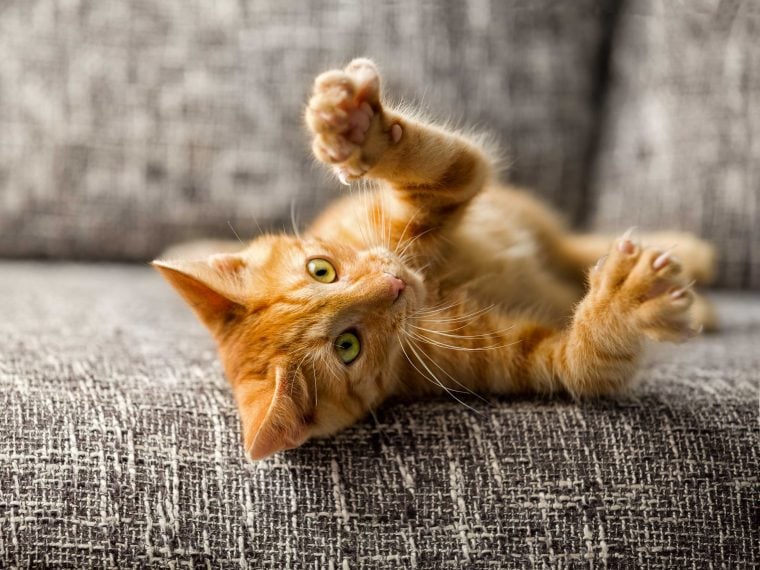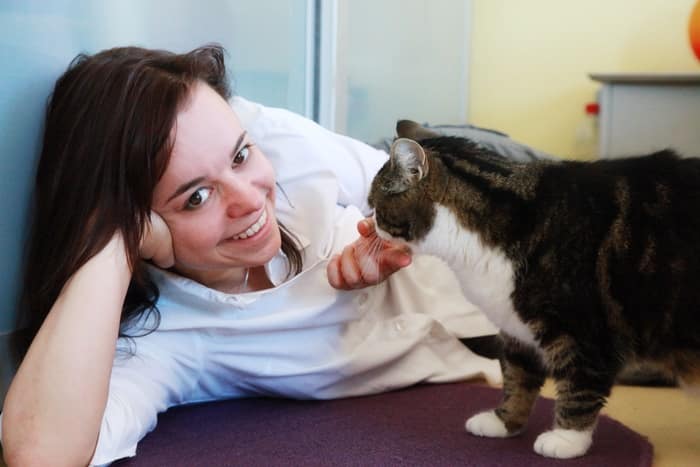
While kittens still hunt everything and jump whenever something moves in front of them, cats become more and more specialized hunters over the course of their lives, only jumping for prey if it is worth it and if the object is in front of them. of them also feels like “real” prey. Very often this specialization ends in the misconception that an adult or even older cat simply does not want to play anymore. In fact, a cat plays for life – because it stays a small predator for life, which through the game practices and simulates the successful hunt for food, even if we open a box for them every day. What should you pay attention to species-appropriate play with the cat lifetime warranty ? Here are the 3 main rules!
1. The game must be realistic
Honestly? How intensely did you deal with the behavior of a mouse, a small moth, or perhaps a bird? Not yet? But you should, because a game is particularly exciting for your cat when it particularly similar to a real hunt East. At toys as realistic as possible starting with its movements and sounds, every detail stimulates the hunting instinct of your mini tiger.
A cat’s prey is small – like a mouse, it carefully moves through the rustling leaves. She freezes when she is in the cat’s home. The small rodent may shiver a little in fear and rush to a new hiding place at lightning speed if the cat becomes inattentive for a moment. A moth is tiny and seems rather inconspicuous. The moth moves in a supposedly uncoordinated way in a kind of “loop” in the air and accidentally enters the cat’s field of vision only to immediately fly away – like a bird. The bird, on the other hand, is well aware of its predator and flies as far as possible out of reach of the cat. Only at an awkward or weak moment does he briefly lose height or sit on the ground at some distance from the cat to peck food.
Species-appropriate play with the cat through realistic imitation
Compare these movements to your own as you play to allow for species-appropriate play with the cat. Do you move the toy realistically, like a bird moving cautiously and largely out of your cat’s reach, only occasionally approaching it in seemingly inattentive ways? Or does your “little bird” not seem to have a very pronounced will to survive while you wave your feather pompom in front of your probably rather angry or even annoyed cat? Watch out for a species-appropriate and fair play. So make sure your cat is always succeeded by catching the toy – otherwise it would be the little hunter constantly frustrate.
2. Bite-sized instead of sprawling game units
The cat’s body is for several small meals “built”. In the wild, it hunts average more than a dozen small and large prey spread over the day (between 15 and 30 is even). A hunting streak lasts on average about 30 minutes and then start again if necessary. Most of a hunt consists of Hide, meditate, observe. It is only at the last moment that the cat rushes to catch its prey – or to hide again. If we want to offer our hunter species-appropriate and interesting game, we must offer several rather short game units spread over the day and not only the famous evening hour, where one is generally surprised that after a few minutes the kitty seems bored and turns away and devotes himself to something else.
If our game as such is not boring, it can A length of time unattractive offer for the animal. The best thing to do is see if you can supplement your daily activities with several longer and shorter sets. A morning short game unit after your first coffee or tea, and finally another just before you start work or leave home. Add to your interactive game solitary food games while you are away. After you get home, you might have a little more time for a longer active play session where you really lure the little tiger out of his stash. Finally, your day might end with another action session, which you will finish slowly and with a slightly larger portion of food to give the cat enough power and satiety for the night.
3. Take your time and have fun!
Species-appropriate play with the cat is also about making it feel like it’s not alone, even under the greatest pressure of time. the center of our world (which they no doubt naturally are), but we would also have all the time in the world for her. Above all, give yourself and your cat time and attention to find out together what you like about the game. Instead of mindlessly waving a feather slingshot in front of her, test which of you loses its temper first and moves as the toy prey is stretched to the point of bursting with only a tiny bit protruding from under the blanket and only moves when the cat for a short looks away for a moment or follows interesting sound. Do you remember the game from your childhood: “Whoever moves first loses?” Play it slightly modified with your cat by slightly moving the toy – you remember: the prey shakes! The more interesting your game, the more fun you and your cat will have!
Besides: If the kitty leaves the field for a brief moment, it does not necessarily mean that it is tired. maybe hunting a bit too exciting for her and she just calms down with a little trick so she can concentrate better. So wait a moment before putting the toy away again if the little hunter really won’t come back.
 Carmen Schell, owner of Cattalk®, works as a trained animal psychologist (ATN) specializing in cats in the Rhine-Main region, mainly around Darmstadt and Frankfurt, and in online coaching. She offers professional support for all questions concerning dress and problematic behavior of velvet paws. In addition to her personal counseling, she regularly gives lectures and seminars nationwide for interested laypersons and professionals. The author has mostly lost his heart for the cats of animal welfare organizations and volunteers in regional animal welfare organizations.
Carmen Schell, owner of Cattalk®, works as a trained animal psychologist (ATN) specializing in cats in the Rhine-Main region, mainly around Darmstadt and Frankfurt, and in online coaching. She offers professional support for all questions concerning dress and problematic behavior of velvet paws. In addition to her personal counseling, she regularly gives lectures and seminars nationwide for interested laypersons and professionals. The author has mostly lost his heart for the cats of animal welfare organizations and volunteers in regional animal welfare organizations.
Help us to further improve our service. Was this article helpful to you?


GIPHY App Key not set. Please check settings